Analysis of Relaxation Time of Temperature in Thermal Response Test for Design of Borehole Size
Abstract
:1. Introduction
2. Field Experiment
3. Methodologies
3.1. MLS
3.2. Estimation of Groundwater Velocity and Effective Thermal Conductivity in the Multilayer
4. Results
4.1. Standard TRT Results
4.2. Determination of Zone Depths
4.3. Estimation of Groundwater Velocity in the Zones
5. Validation of Methodology
5.1. Comparison between Calculated Results and TRT Data
5.2. Analysis Results of Thermal Parameters According to TRT End Time
5.3. Long-Term Simulation Results According to Time-Variable Building Load
6. Estimation of the Circulating Fluid According to the Borehole Size
7. Conclusions
Author Contributions
Funding
Acknowledgments
Conflicts of Interest
Nomenclature
| volumetric heat capacity () | |
| specific heat capacity () | |
| diameter () | |
| electric power consumption [kW] | |
| heat injection () | |
| heat injection rate () | |
| temperature gradient over the logarithmic time () | |
| depth () | |
| flow rate () | |
| the number of zones | |
| radius () | |
| borehole thermal resistance () | |
| temperature (°C) | |
| mean temperature (°C) | |
| dimensionless temperature | |
| time () | |
| relaxation time of temperature, RTT () | |
| time at stopping the heat supply (h) | |
| effective fluid velocity () | |
| Darcy velocity () | |
| Shank spacing from the center of the pipe to the center of the borehole | |
| Greek letters | |
| thermal diffusivity () | |
| integration parameter | |
| density () | |
| thermal conductivity () | |
| polar angle () | |
| Euler’s constant, (0.5772) | |
| Subscripts | |
| initial value | |
| cooling | |
| fluid | |
| borehole | |
| effective | |
| heating | |
| heat pump | |
| inside | |
| layer | |
| outside | |
| pipe | |
| soil | |
| water | |
| Zone | |
References
- Ozgener, O.; Hepbasli, A.; Ozgener, L. A parametric study on the exergoeconomic assessment of a vertical ground-coupled (geothermal) heat pump system. Build. Environ. 2007, 42, 1503–1509. [Google Scholar] [CrossRef]
- Ozgener, O.; Hepbasli, A. Performance analysis of a solar-assisted ground-source heat pump system for greenhouse heating: An experimental study. Build. Environ. 2005, 40, 1040–1050. [Google Scholar] [CrossRef]
- Nam, Y.; Ooka, R.; Hwang, S. Development of a numerical model to predict heat exchange rates for a ground-source heat pump system. Energy Build. 2008, 40, 2133–2140. [Google Scholar] [CrossRef]
- Carotenuto, A.; Marotta, P.; Massarotti, N.; Mauro, A.; Normino, G. Energy piles for ground source heat pump applications: Comparison of heat transfer performance for different design and operating parameters. Appl. Therm. Eng. 2017, 124, 1492–1504. [Google Scholar] [CrossRef]
- Nam, Y.; Chae, H.B. Numerical simulation for the optimum design of ground source heat pump system using building foundation as horizontal heat exchanger. Energy 2014, 73, 933–942. [Google Scholar] [CrossRef]
- Choi, J.C.; Lee, S.R.; Lee, D.S. Numerical simulation of vertical ground heat exchangers: Intermittent operation in unsaturated soil conditions. Comput. Geotech. 2011, 38, 949–958. [Google Scholar] [CrossRef]
- Mogensen, P. Fluid to duct wall heat transfer in duct system heat storages. Doc. Swed. Counc. Build. Res. 1983, 16, 652–657. [Google Scholar]
- Carslaw, H.S.; Jeager, J.C. Conduction of Heat in Solids; Oxford University Press: Oxford, UK, 1959. [Google Scholar]
- Signorelli, S.; Bassetti, S.; Pahud, D.; Kohl, T. Numerical evaluation of thermal response tests. Geothermics 2007, 36, 141–166. [Google Scholar] [CrossRef]
- Fossa, M.; Rolando, D.; Pasquier, P. Pulsated thermal response test experiment and modelling for ground thermal property estimation. In Proceedings of the IGSHPA Research, Stockholm, Sweden, 18–20 September 2018. [Google Scholar]
- Angelotti, A.; Alberti, L.; la Licata, I.; Antelmi, M. Energy performance and thermal impact of a Borehole Heat Exchanger in a sandy aquifer: Influence of the groundwater velocity. Energy Convers. Manag. 2014, 77, 700–708. [Google Scholar] [CrossRef]
- Choi, J.C.; Park, J.; Lee, S.R. Numerical evaluation of the effects of groundwater flow on borehole heat exchanger arrays. Renew. Energy 2013, 52, 230–240. [Google Scholar] [CrossRef]
- Hecht-Méndez, J.; De Paly, M.; Beck, M.; Bayer, P. Optimization of energy extraction for vertical closed-loop geothermal systems considering groundwater flow. Energy Convers. Manag. 2013, 66, 1–10. [Google Scholar] [CrossRef]
- Lee, C.K.; Lam, H. A modified multi-ground-layer model for borehole ground heat exchangers with an inhomogeneous groundwater flow. Energy 2012, 47, 378–387. [Google Scholar] [CrossRef]
- Wang, H.; Qi, C.; Du, H.; Gu, J. Thermal performance of borehole heat exchanger under groundwater flow: A case study from Baoding. Energy Build. 2009, 41, 1368–1373. [Google Scholar] [CrossRef]
- Wagner, V.; Blum, P.; Kübert, M.; Bayer, P. Analytical approach to groundwater-influenced thermal response tests of grouted borehole heat exchangers. Geothermics 2013, 46, 22–31. [Google Scholar] [CrossRef]
- Spitler, J.D.; Yavuzturk, C.; Rees, S.J. Development of an insitu system and analysis procedure for measuring ground thermal properties. In Proceedings of the Terrastock, Stuttgart, Germany, 28 August–1 September 2000. [Google Scholar]
- Smith, M.; Perry, R. In situ testing and thermal conductivity testing. In Proceedings of the 1999 GeoExchange Technical Conference and Expo, Oklahoma, OK, USA, 16–19 May 1999. [Google Scholar]
- Kavanaugh, S.P.; Xie, L.; Martin, C. Investigation of methods for determining soil and rock formation thermal properties from short-term field tests. Final Report ASHRAE TRP-1118. 2000. Available online: https://www.techstreet.com/standards/rp-1118-investigation-of-methods-for-determining-soil-and-rock-formation-thermal-properties-from-short-term-field-tests?product_id=1711876 (accessed on 14 May 2020).
- Gehlin, S.E.A.; Hellström, G. Comparison of four models for thermal response test evaluation. ASHRAE Trans. 2003, 109, 131–142. [Google Scholar]
- American Society of Heating, Refrigerating and Air-Conditioning Engineers. ASHRAE Handbook–HVAC Applications; American Society of Heating, Refrigerating and Air-Conditioning Engineers, Inc.: Atlanta, GA, USA, 2011. [Google Scholar]
- Wagner, V.; Bayer, P.; Bisch, G.; Kübert, M. Hydraulic characterization of aquifers by thermal response testing: Validation by large-scale tank and field experiments. Water Resour. Res. 2014, 50, 71–85. [Google Scholar] [CrossRef]
- Chae, H.; Nagano, K.; Sakata, Y.; Katsura, T.; Kondo, T. Estimation of fast groundwater flow velocity from thermal response test results. Energy Build. 2020, 206, 109571. [Google Scholar] [CrossRef]
- Sakata, Y.; Katsura, T.; Nagano, K. Multilayer-concept thermal response test: Measurement and analysis methodologies with a case study. Geothermics 2018, 71, 178–186. [Google Scholar] [CrossRef]
- Sakata, Y.; Katsura, T.; Nagano, K.; Ishizuka, M. Field analysis of stepwise effective thermal conductivity along a borehole heat exchanger under artificial conditions of groundwater flow. Hydrology 2017, 4, 21. [Google Scholar] [CrossRef] [Green Version]
- Kallio, J.; Leppäharju, N.; Martinkauppi, I.; Nousiainen, M. Geoenergy research and its utilization in Finland. Geol. Surv. Finl. 2011, 49, 179–185. [Google Scholar]
- Fujii, H.; Okubo, H.; Nishi, K.; Itoi, R.; Ohyama, K.; Shibata, K. An improved thermal response test for U-tube ground heat exchanger based on optical fiber thermometers. Geothermics 2009, 38, 399–406. [Google Scholar] [CrossRef]
- Günzel, U.; Wilhelm, H. Estimation of the in-situ thermal resistance of a borehole using the Distributed Temperature Sensing (DTS) technique and the Temperature Recovery Method (TRM). Geothermics 2000, 29, 689–700. [Google Scholar] [CrossRef]
- Freifeld, B.; Finsterle, S.; Onstott, T.C.; Toole, P.; Pratt, L.M. Ground surface temperature reconstructions: Using in situ estimates for thermal conductivity acquired with a fiber-optic distributed thermal perturbation sensor. Geophys. Res. Lett. 2008, 35, 3–7. [Google Scholar] [CrossRef] [Green Version]
- McDaniel, A.; Tinjum, J.M.; Hart, D.; Lin, Y.-F.; Stumpf, A.J.; Thomas, L. Distributed thermal response test to analyze thermal properties in heterogeneous lithology. Geothermics 2018, 76, 116–124. [Google Scholar] [CrossRef]
- Saito, T.; Hamamoto, S.; Mon, E.E.; Takemura, T.; Saito, H.; Komatsu, T.; Moldrup, P. Thermal properties of boring core samples from the Kanto area, Japan: Development of predictive models for thermal conductivity and diffusivity. Soils Found. 2014, 54, 116–125. [Google Scholar] [CrossRef] [Green Version]
- Santa, G.D.; Peron, F.; Galgaro, A.; Cultrera, M.; Bertermann, D.; Müller, J.; Bernardi, A. Laboratory measurements of gravel thermal conductivity: An update methodological approach. Energy Procedia 2017, 125, 671–677. [Google Scholar] [CrossRef]
- Hamdhan, I.N.; Clarke, B.G. Determination of thermal conductivity of coarse and fine sand soils. In Proceedings of the World Geothermal Congress, Bali, Indonesia, 25–29 April 2010. [Google Scholar]
- Colangelo, F.; De Luca, G.; Ferone, C.; Mauro, A. Experimental and numerical analysis of thermal and hygrometric characteristics of building structures employing recycled plastic aggregates and geopolymer concrete. Energies 2013, 6, 6077–6101. [Google Scholar] [CrossRef] [Green Version]
- Diao, N.; Li, Q.; Fang, Z. Heat transfer in ground heat exchangers with groundwater advection. Int. J. Therm. Sci. 2004, 43, 1203–1211. [Google Scholar] [CrossRef]
- Eklöf, C.; Gehlin, S. A Mobile Equipment for Thermal Response Test. Master’s Thesis, Lulea University of Technology, Lulea, Sweden, 1996. [Google Scholar]
- Raymond, J.; Therrien, R.; Gosselin, L.; Lefebvre, R. A review of thermal response test analysis using pumping test concepts. Ground Water 2011, 49, 932–945. [Google Scholar] [CrossRef]
- Yavuzturk, C.; Spitler, J.D. Short time step response factor model for vertical ground loop heat exchangers. ASHRAE Trans. 1999, 105, 475–485. [Google Scholar]
- Choi, W.; Ooka, R. Interpretation of disturbed data in thermal response tests using the infinite line source model and numerical parameter estimation method. Appl. Energy 2015, 148, 476–488. [Google Scholar] [CrossRef]
- Nagano, K. Standard Procedure of Standard TRT, Version 2.0; Heat Pump and Thermal Storage Technology Center of Japan: Tokyo, Japan, 2011. [Google Scholar]
- Lamarche, L.; Raymond, J.; Pambou, C.H.K. Evaluation of the internal and borehole resistances during thermal response tests and impact on ground heat exchanger design. Energies 2017, 11, 38. [Google Scholar] [CrossRef] [Green Version]
- Nagano, K.; Katsura, T.; Takeda, S. Development of a design and performance prediction tool for the ground source heat pump system. Appl. Therm. Eng. 2006, 26, 1578–1592. [Google Scholar] [CrossRef]
- Katsura, T.; Nagano, K.; Takeda, S. Method of calculation of the ground temperature for multiple ground heat exchangers. Appl. Therm. Eng. 2008, 28, 1995–2004. [Google Scholar] [CrossRef]
- Katsura, T.; Nagano, K.; Narita, S.; Takeda, S.; Nakamura, Y.; Okamoto, A. Calculation algorithm of the temperatures for pipe arrangement of multiple ground heat exchangers. Appl. Therm. Eng. 2009, 29, 906–919. [Google Scholar] [CrossRef]
- Katsura, T.; Nagano, K.; Takeda, S.; Shimakura, K. Heat transfer experiment in the ground with ground water advection. Proceedings of 10th Energy Conservation Thermal Energy Storage Conference Ecostock, Stockton, NJ, USA, May 31–June 2 2006. [Google Scholar]
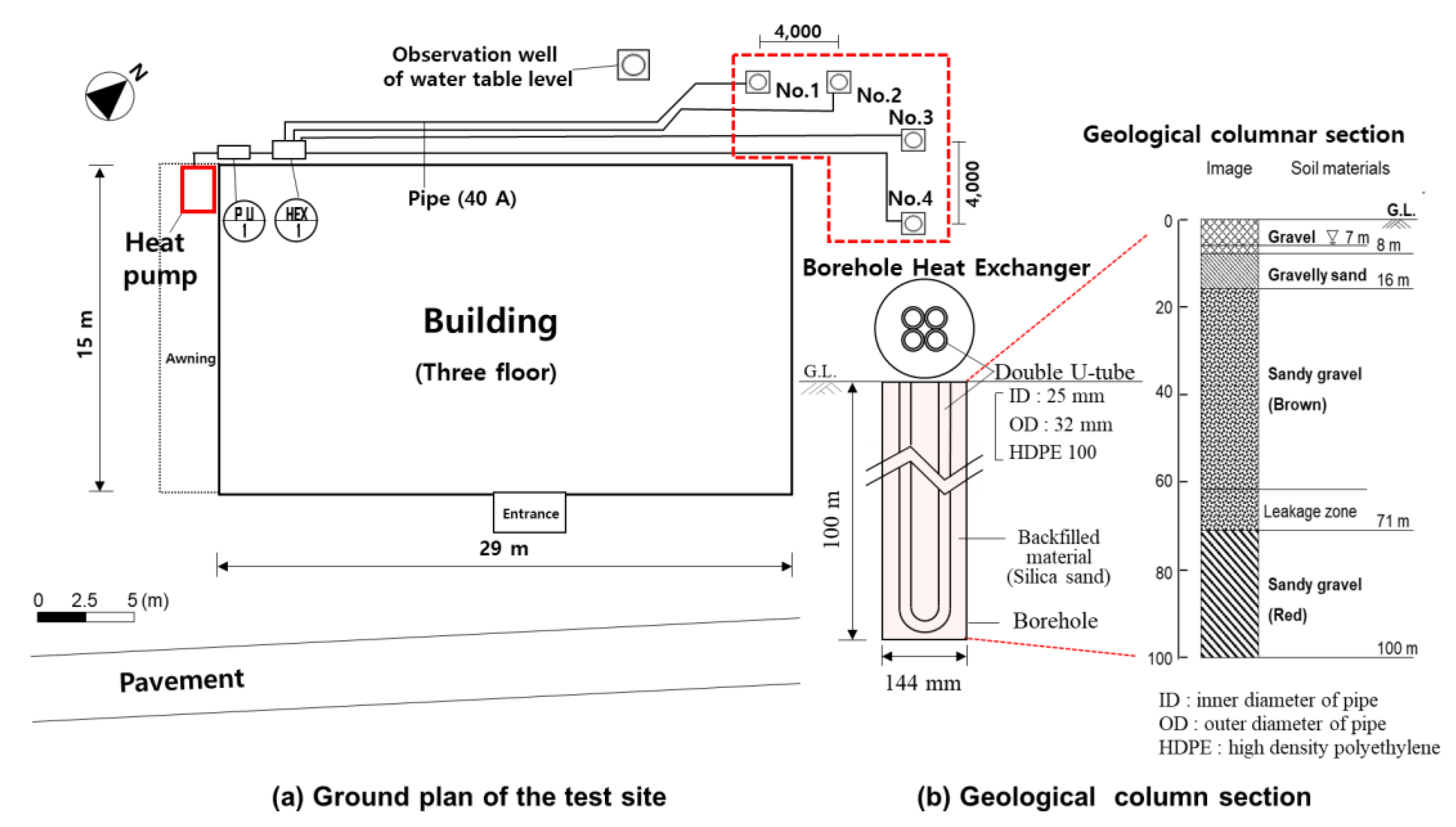
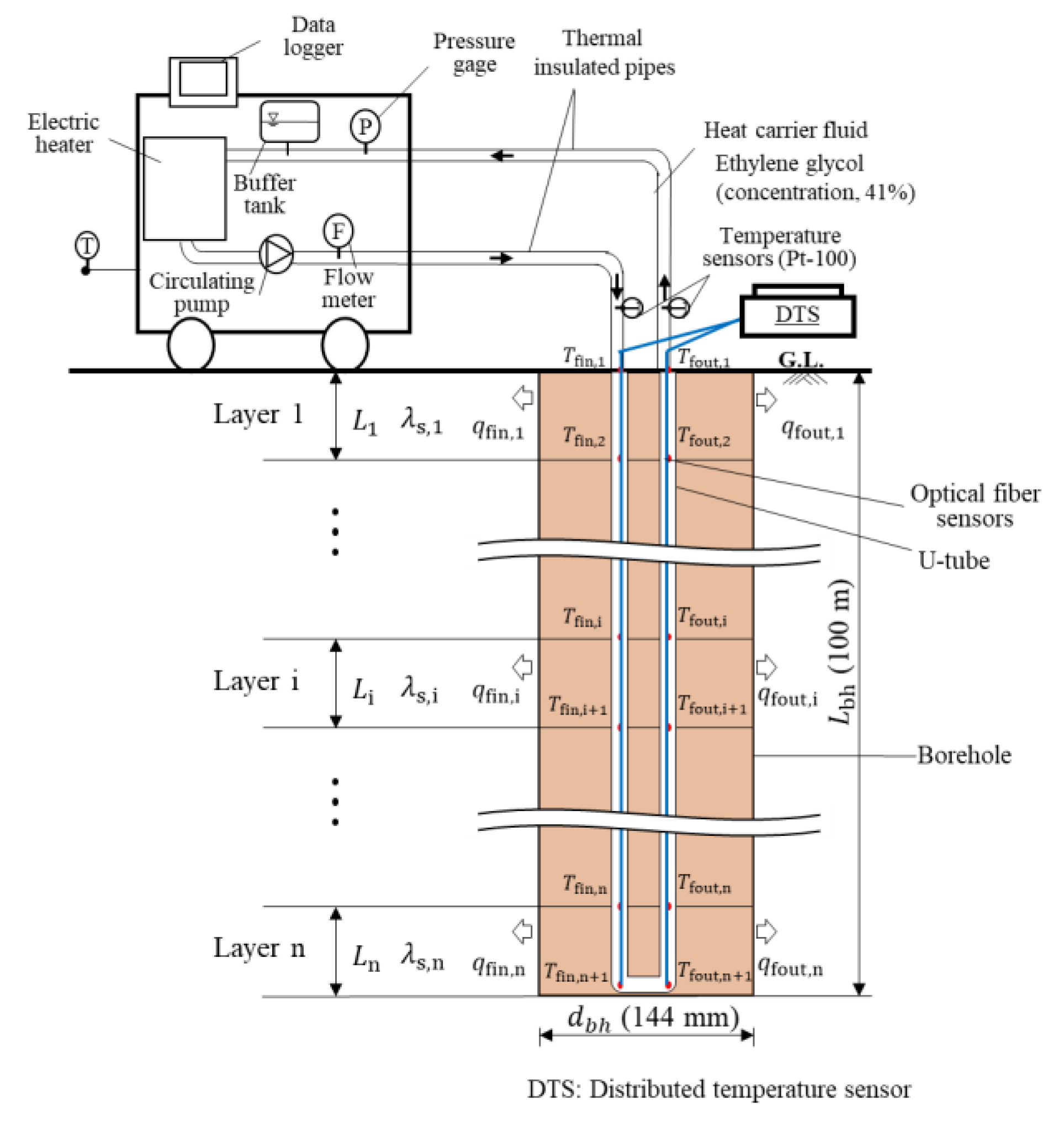
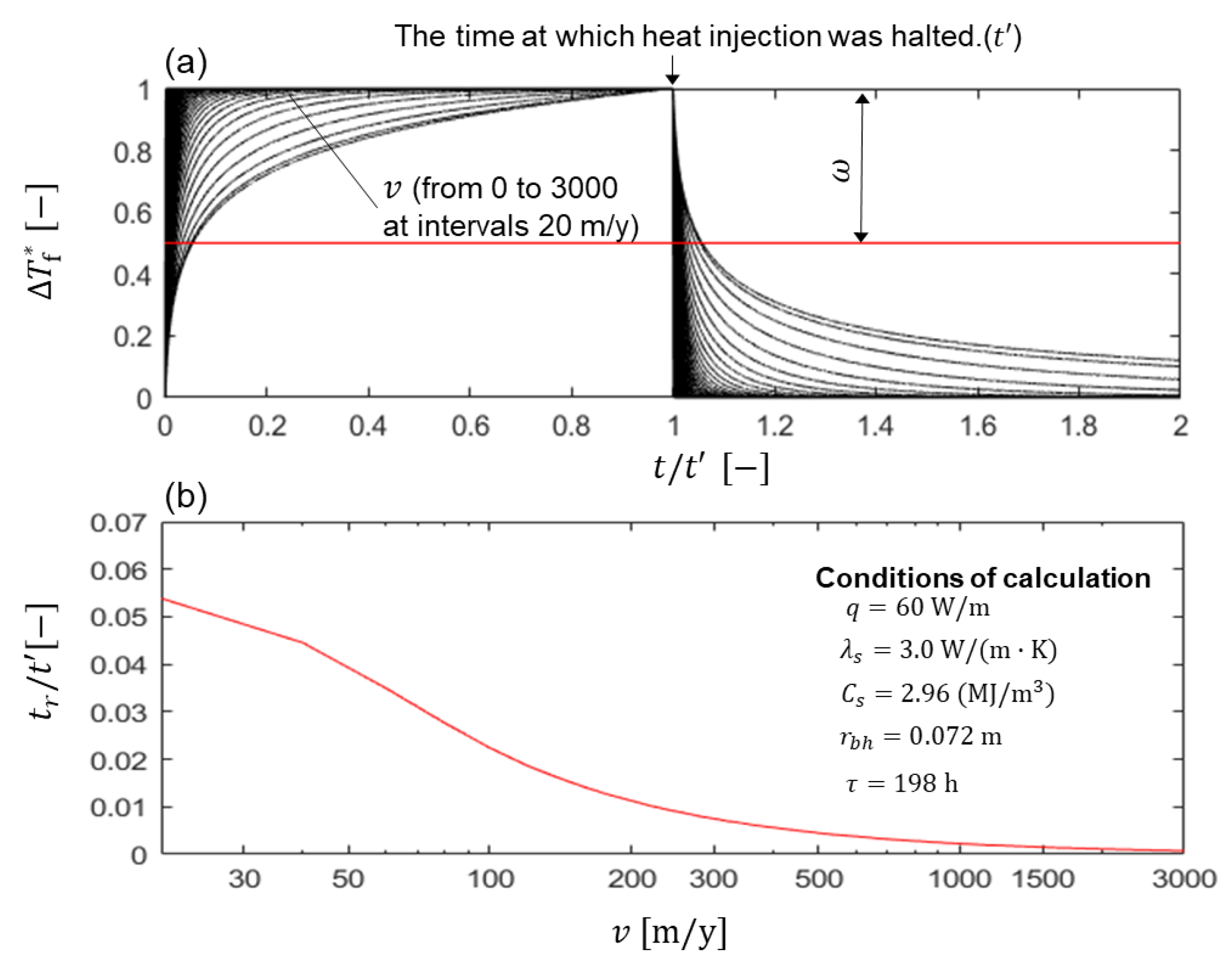

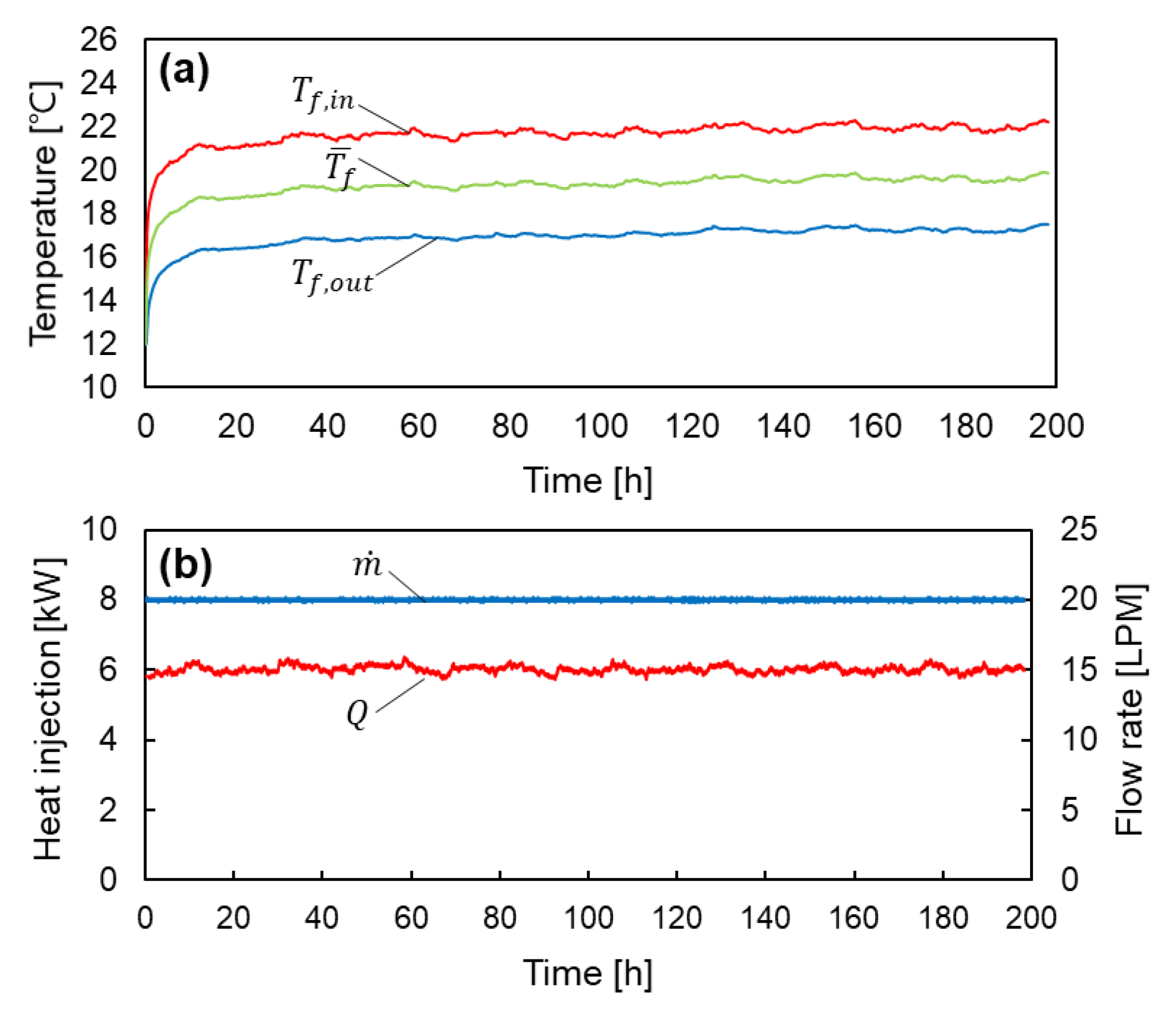



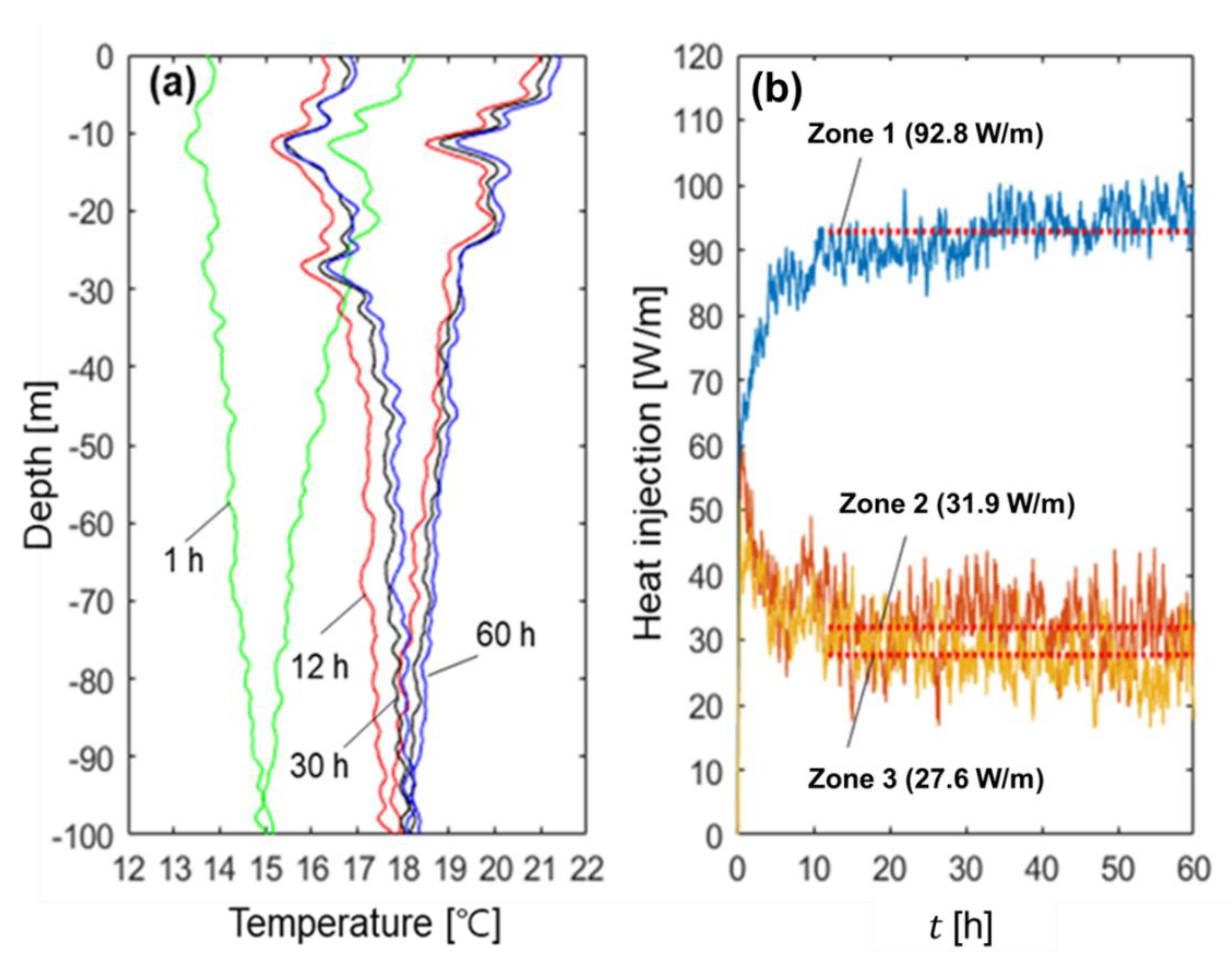
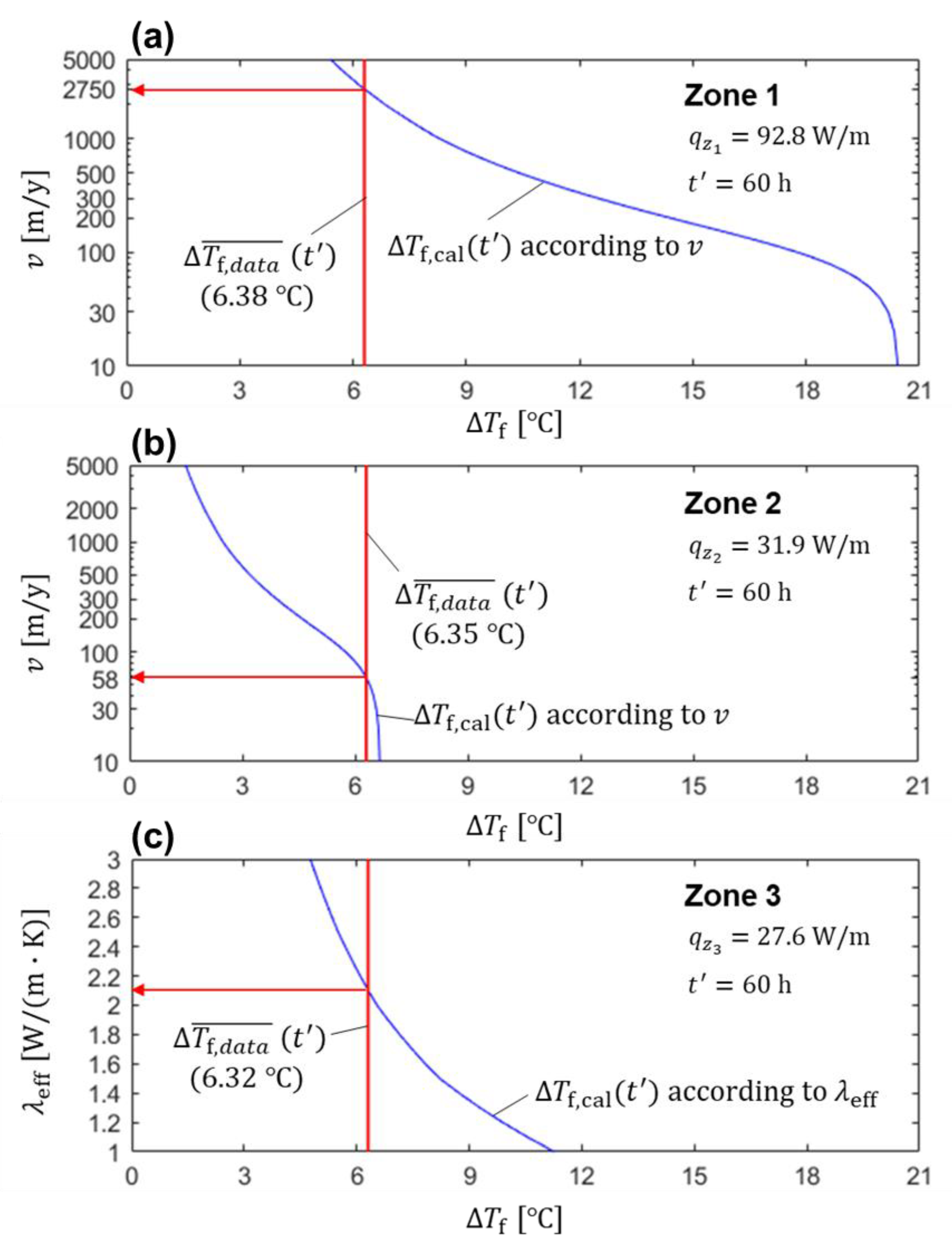
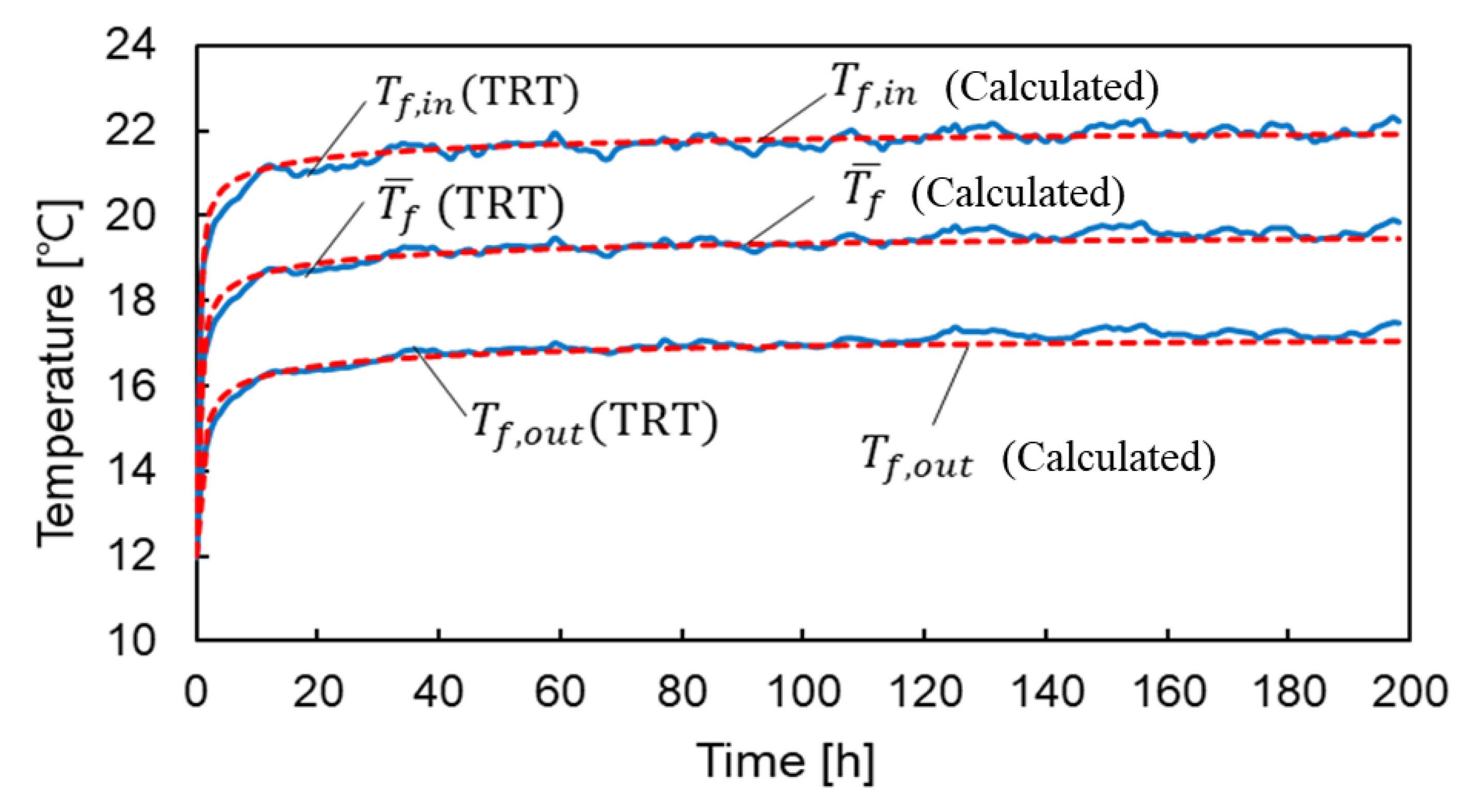

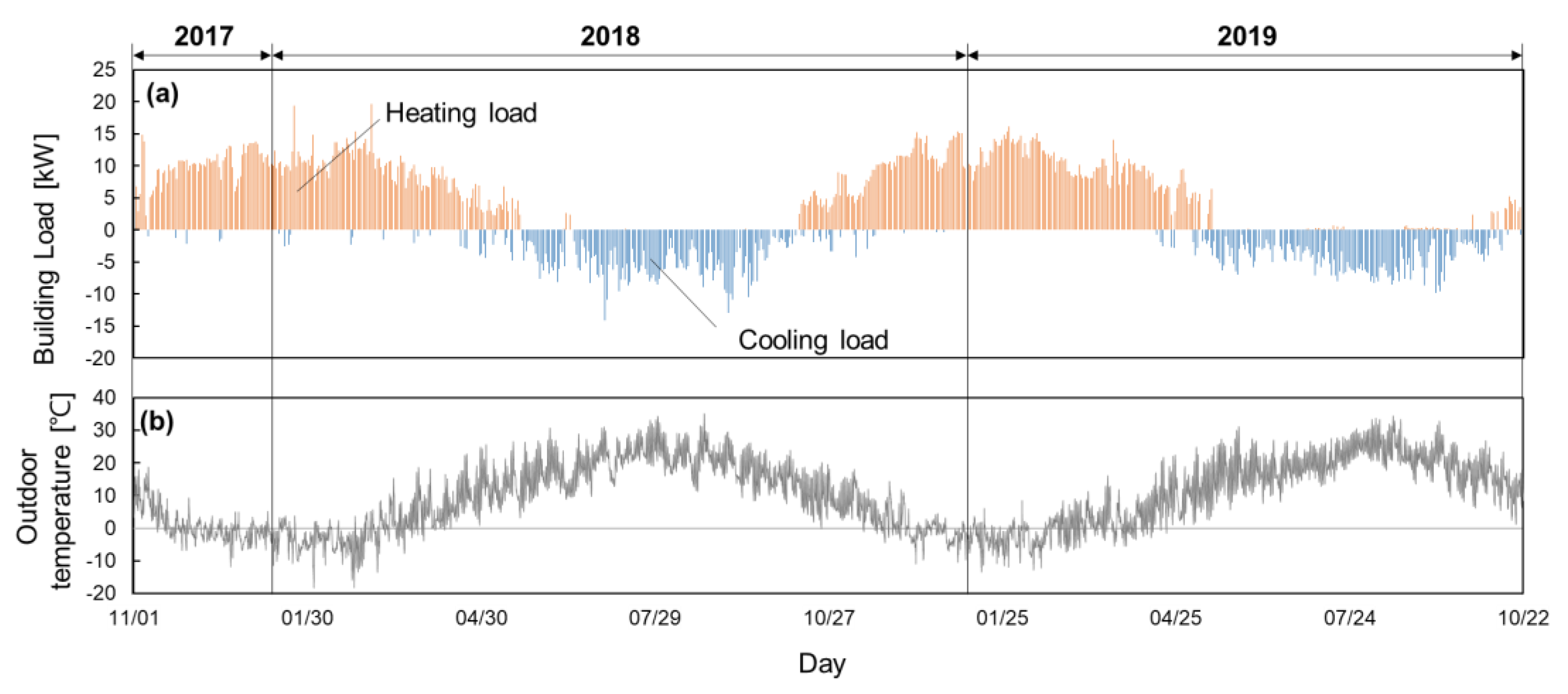

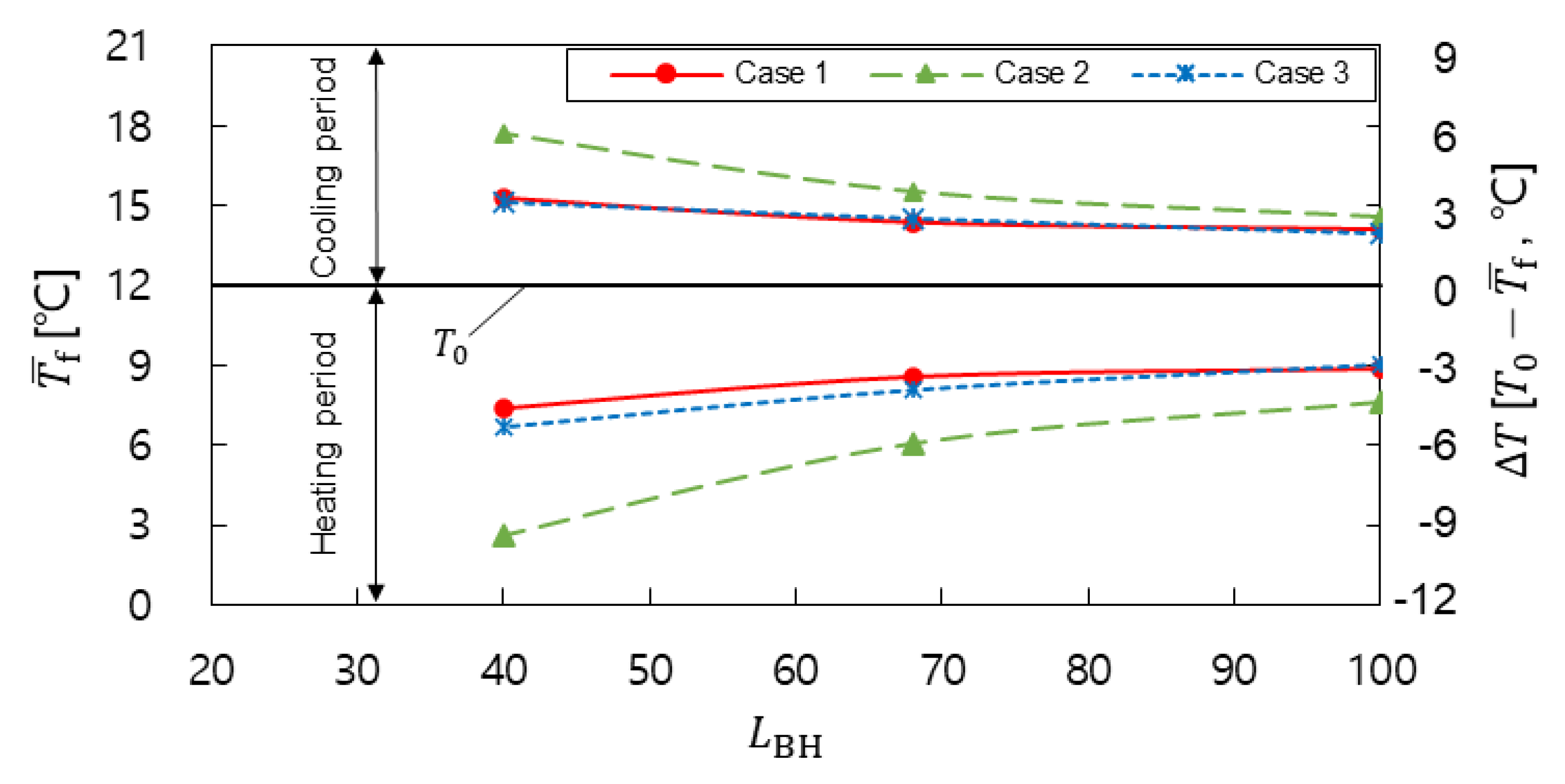

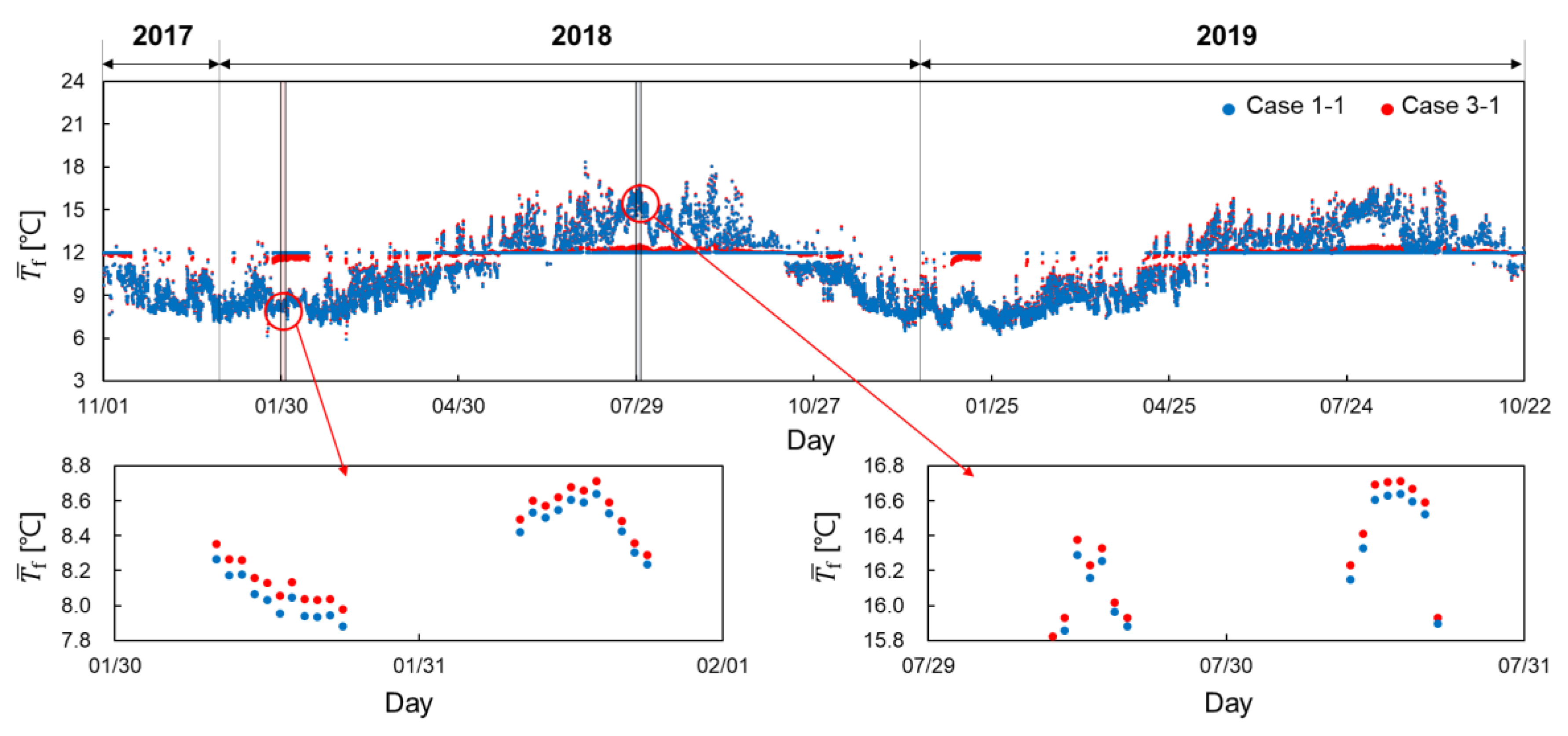

| Layer | |||
|---|---|---|---|
| Zone 1 | 0–40 | ||
| Zone 2 | 40–68 | ||
| Zone 3 | 68–100 |
| Case | Case 1 (End Time = 60 h) | Case 2 (End Time = 48 h) | Case 3 (End Time = 96 h) | |
|---|---|---|---|---|
| Zone 1 | [) | 92.8 | 91.8 | 94 |
| ) | 2.4 | 2.4 | 2.13 | |
| ) | 2750 | 3250 | 2730 | |
| Zone 2 | ) | 31.9 | 32.1 | 31.1 |
| ) | 2.4 | 2.4 | 2.36 | |
| ) | 58 | 89 | 28 | |
| Zone 3 | ) | 27.6 | 28.4 | 26.1 |
| ) | 2.1 | 2.36 | 1.97 | |
| ) | 0 | 0 | 0 | |
| Parameter | Measurement Uncertainty |
|---|---|
| ) | |
| ) | |
| ) | |
| ) | |
| ) |
| Case | ||||
|---|---|---|---|---|
| Case 1 (proposed method) | Case 1-1 (three zones) | 100 (40/28/32) | 2.4/2.4/2.1 | 2750/58/0 |
| Case 1-2 (two zones) | 68 (40/28) | 2.4/2.4 | 2750/58 | |
| Case 1-3 (one zone) | 40 | 2.4 | 2750 | |
| Case 2 (conventional TRT analysis method) | Case 2-1 | 100 | 9.5 | 0 |
| Case 2-2 | 68 | 9.5 | 0 | |
| Case 2-3 | 40 | 9.5 | 0 | |
| Case 3 (previous research [23]) | Case 3-1 | 100 | 4.7 | 120 |
| Case 3-2 | 68 | 4.7 | 120 | |
| Case 3-3 | 40 | 4.7 | 120 | |
© 2020 by the authors. Licensee MDPI, Basel, Switzerland. This article is an open access article distributed under the terms and conditions of the Creative Commons Attribution (CC BY) license (http://creativecommons.org/licenses/by/4.0/).
Share and Cite
Chae, H.; Nagano, K.; Sakata, Y.; Katsura, T.; Serageldin, A.A.; Kondo, T. Analysis of Relaxation Time of Temperature in Thermal Response Test for Design of Borehole Size. Energies 2020, 13, 3297. https://doi.org/10.3390/en13133297
Chae H, Nagano K, Sakata Y, Katsura T, Serageldin AA, Kondo T. Analysis of Relaxation Time of Temperature in Thermal Response Test for Design of Borehole Size. Energies. 2020; 13(13):3297. https://doi.org/10.3390/en13133297
Chicago/Turabian StyleChae, Hobyung, Katsunori Nagano, Yoshitaka Sakata, Takao Katsura, Ahmed A. Serageldin, and Takeshi Kondo. 2020. "Analysis of Relaxation Time of Temperature in Thermal Response Test for Design of Borehole Size" Energies 13, no. 13: 3297. https://doi.org/10.3390/en13133297






